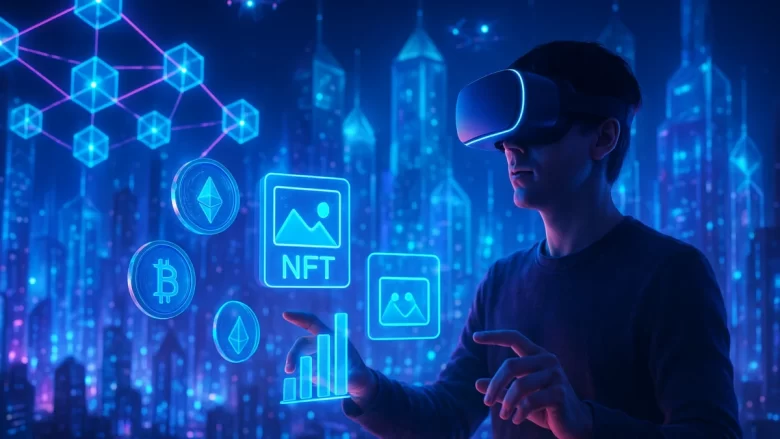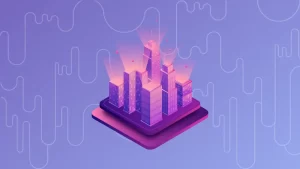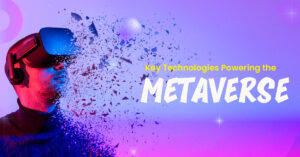Digital ownership has been around for a while, but it’s undergoing a revolution with the rapid expansion of NFTs and the metaverse. The metaverse and non-fungible tokens (NFTs) are changing the way we think about ownership, identity, and interactions in virtual environments. In this blog, we’ll explore the practical applications of NFTs, how they can transform the metaverse and enable true ownership, and the possibilities and challenges of such an evolving environment. Whether you’re new to the metaverse or an NFT enthusiast, get ready to explore the possibilities of these technologies.
Understanding NFTs: A Quick Look
Non-fungible tokens, often referred to as NFTs, are unique digital assets that represent ownership of specific items or materials, including real estate, virtual goods, music, movies, artwork, etc. Unlike Bitcoin or Ethereum, which are divisible and unique, NFTs are unique. Each token is tied to the blockchain, ensuring security, publicity, and immutability. NFTs are attractive because they create ownership and authenticity. Collectors can own unusual and unique digital objects, but it also offers artists the opportunity to profit from their work. The new ownership paradigm in the digital world is based on NFTs.
Metaverse, The Digital Frontier:
The metaverse is a collaborative, virtual, shared space that combines the physical and digital worlds. Imagine it as a connected network of attractive virtual environments that people can access through technologies such as augmented reality (AR) and virtual reality (VR). The metaverse is growing rapidly, encompassing everything from e-commerce and workplaces to gaming and social interactions. In this growing digital age, NFTs are becoming an essential tool for defining value and ownership. They are essential for building dynamic, user-driven economies in these simulated environments.
NFTs as Proof of Ownership in the Metaverse:
The ability of NFTs to provide proof of ownership is one of their most important contributions to the metaverse. With traditional digital assets, there is no way to securely confirm or transfer ownership. NFTs, on the other hand, use blockchain technology to confirm ownership, allowing people to own virtual properties, artwork, avatars, and more in the metaverse. This ownership is not limited to the digital realm; often, the rights and financial rewards extend into the physical world as well. For example, owning an NFT can grant you access to exclusive events, content, or royalty streams. NFTs pave the way for a decentralized and democratized ownership system, transforming the experience for creators and users in the Metaverse.
How NFTs Can Change the Metaverse:
The applications for NFTs in the metaverse are diverse and constantly evolving. Gaming is one of the most notable applications. Virtual worlds like “Decentraland” and “The Sandbox” allow users to buy, build, and monetize virtual properties using NFTs. NFTs also introduce the concept of monetization, where players can earn real money by working in the game. NFTs are also changing fashion and digital identity, as people create and purchase unique clothing and accessories for their avatars in the metaverse. NFTs also allow artists to monetize their work in entirely different ways, such as through virtual concerts, digital art galleries, and immersive experiences. NFTs also empower corporations by enabling the sale of virtual branded products and services within these virtual environments. Our creativity limits the possibilities.
NFTs in the Metaverse: The Future and Challenges
While NFTs offer revolutionary opportunities, they also come with challenges. A major concern is the environmental impact of blockchain systems, as they require a lot of electricity to operate. High costs and the knowledge curve associated with blockchain wallets and marketplaces also continue to impact the storage and access of NFTs. Legal uncertainty surrounding fraud and intellectual property rights also limits mass adoption. But the future looks bright. Innovations in blockchain technology, such as more energy-efficient consensus processes and improved interoperability, are addressing these challenges. Furthermore, the demand for NFTs will only increase as more people interact with the metaverse, driving technological development and new applications. To stay ahead in the digital age, businesses and individuals need to understand and adapt to this reality.
Actionable Steps for Your Digital Journey:
The NFT-powered metaverse isn’t just a dream of the future; it’s happening now. Understanding the connection between NFTs and the metaverse is essential for creators, businesses, and fans to realize their full potential. Whether you want to create ownership, profit from innovation, or explore new areas of digital experiences, it’s time to take action. Stay tuned, keep discovering, and don’t be afraid to actively participate in this ongoing change.
FAQs:
1. What exactly is an NFT?
NFTs (non-fungible tokens) are unique digital tokens stored on a blockchain that represent ownership of a specific asset, such as digital art, music, movies, or metaverse properties. Unlike cryptocurrencies, which are divisible and interchangeable with anything identical, NFTs are unique because they are indivisible.
2. How does an NFT gain ownership of the metaverse?
Using blockchain technology, NFTs provide a secure, open method of confirming ownership. Whether it’s virtual real estate, avatars, or collectibles, by purchasing an NFT, consumers gain immutable proof of ownership, giving them rights to the underlying assets in the metaverse.
3. What are some typical use cases for metaverse NFTs?
NFTs are used in various ways in the metaverse, including in games, where they facilitate the buying and selling of virtual assets, merchandise, and skins. They also enable virtual fashion for avatars, customization of digital identities, interactive events such as virtual concerts, and monetization of digital art in galleries.
4. What challenges do you face when using metaverse NFTs?
Key challenges with NFTs include the environmental impact of blockchain’s energy consumption, high prices that limit access, the learning curve associated with blockchain technology, and the legal uncertainties surrounding intellectual property and fraud. Broad adoption depends on solving these issues.
5. How will NFTs change in the metaverse in the future?
Greater interoperability between platforms, more energy-efficient blockchain solutions, greater accessibility, and integration into a wider range of applications could be hallmarks of NFTs in the future metaverse. Innovation will lead to more complex use cases and greater adoption across industries.




